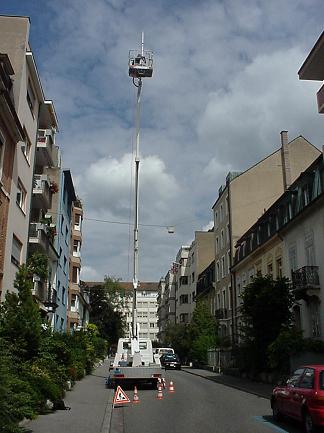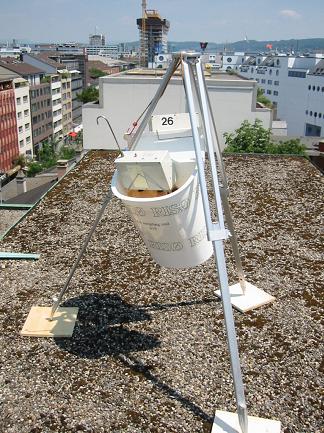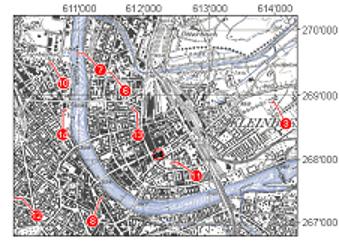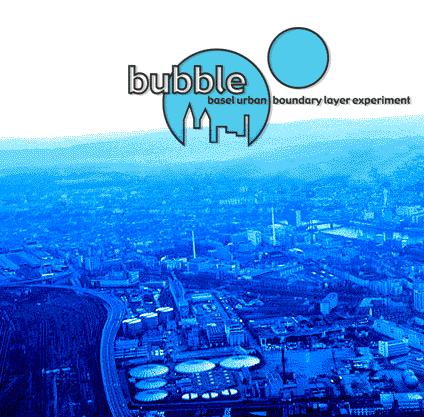
 |
||
| Scientists' Contributions | ||
HOW DOES SMOKE SPREAD OVER A CITY - IMPRESSIONS FROM A FIELD CAMPAIGN
Sven-Erik Gryning,
Risoe National Laboratory, Denmark
Email: Sven-Erik.Gryning@risoe.dk
When you drive along the German highway and enter Switzerland at Basel, you drive a few kilometres before passing the bridge over the Rhein. This part of Basel is named Klein-Basel. Leaving the highway for Klein-Basel brings you to a town with 4 to 6 storey apartment buildings, the enormous administration buildings of well-known swiss chemical firms and a web of narrow somewhat parallel roads. The mean roof height is 15 metres. You will meet names like Clarastrasse, Claraplatz, Claraspital, ClaraApothek… a lot of names with Clara.
Here we investigated this summer how smoke spreads over a city; taking part in a major micrometeorological study called BUBBLE (Basel UrBan Boundary Layer Experiment). Numerous investigations already exist on the dispersion of pollution in street canyons, but we wanted to see how it spreads above the roofs in a large city. The data are intended to be used for validation of present and future models of atmospheric dispersion. To get such data we performed tracer experiments. The idea is that we release a tracer that can be detected in very low concentrations. Then we sample the tracer in plastic bags with samplers on roofs and finally we analyse the bags for their content of the tracer. The technique we used was developed 25 years ago in collaboration between Risø and DMU. The tracer is SF6, it is completely artificial and therefore the concentration in the atmosphere is very low. It is non-toxic and chemically stable. It is possible to detect it in very low concentrations. If you add two spoons (topped) of sugar to the Bodensee, the change of concentration corresponds to the SF6 concentrations we measured in Basel.
The tracer experiments were designed for north-westerly wind directions, taking advantage of a thermally driven wind system that develops over Basel under some synoptic conditions in summer - named Clarawind. In the afternoon Clarawind is characterised by a persistent north-westerly direction. However in the morning it gives rise to drainage flows from the nearby mountains in the opposite direction. Due to logistics we were forced to start the procedure for our tracer experiments already in the morning well before the north-westerly Clarawind started to develop in the afternoon - a real challenge for micrometeorologists.
 The cherry picker during a tracer release... The release is from the top of the extension that can be seen above the basket of the cherry picker. The Broholmer dog lived in the house on the left. |
We released the tracer at the roof of a parking house in Klein-Basel and sampled air with tracer in plastic bags on roofs. In one of the experiments the north-westerly wind did not develop, so instead we released the tracer from a cherry picker. One of us had to spend 5 hours in the basket 18 metres above the street to secure a proper tracer release. When you sit up there in the small basket, you are just a few metres away from the terraces of the Penthouse apartments. In general the Swiss people are very kind and curious and take it as an experience to get unexpected visitors (uventede gæster) outside their terrace. After some time a lady appeared on the terrace asking politely what I was doing. I told her. Then she asked if I was a Dane. I confirmed. Then she told that her dog was Danish, and a big black dogface appeared above the fence on the terrace - a Broholmer. The women told me that her dog was named Hannibal - and she had picked it up as a puppy in Randers. Its childhood was in Denmark, maybe it still remembers some Danish - please say something to the dog in Danish. In order to keep the good atmosphere I addressed the dog in Danish, carefully avoiding words like jump and come here which could have been disastrous for an obedient dog that lives on a Penthouse-terrace at the 6th floor.
The cherry picker was for the experiment parked in a so-called blaue-zone; a two-hour-limited street parking. Generally parking in Basel is a big problem, and therefore Lars and Søren brought bicycles for the experiment. Søren had a Kildemoes delivery bicycle (budcykel). Two times they were stopped in bicycle razzias - three policemen stop all bicycles - one secure that nobody sneaks away - and two check bells etc... Needless to say that Søren’s and Lars’es bicycles were in perfect conditions but it also was clear that the police was not acquainted with Kildemoes delivery bicycles. At the university one of the students offered to buy Sørens bicycle.
 Two tracer samplers, attached to a tripod, on a roof in Klein-Basel 26 metres above the ground during one of the experiments. (26 is the unit number, but I would check if it is 26 m above street. Typically it was 16-18 m above street +1.5 for the triangular support) |
The experiments were performed with tracer release on a roof or from a cherry picker and sampling on roofs. This meant that the samplers had to be transported from the street through private apartments or high-security administration buildings of the chemical firms to the roofs of Klein-Basel for each experiment. This lead to a very complicated procedure for keys and gradually Switzerland in our mind changed name to Schlüsselland. But it all worked out very well thanks to the devoted effort of the sampler operators, mainly university students, and of course Ekaterina, Lars and Søren. Despite spending hours on the roofs of Basel sometimes several days in row devotion never failed - always positive and ready for new experiments.
Concerning language it is of course a little messy in a city that lies in the corner of France, Germany and Switzerland. It was interesting to note that even people from Zürich could have difficulties to understand the Klein-Baseler people. It was mandatory in the management group for the experiment, that when we called the Swiss Meteorological Service in Zürich for a detailed forecast for the Basel area, then the first point on the agenda was to ask the forecaster to speak german and abstain from swiss-german. Actually danish was not uncommon in the management group as two of the members knew Danish well having been guest-scientists at Risø.
 Illustration of the complexity of the wind field during one of the experiments. The red bars indicate the wind direction, the vanes translated into wind speed. The blue colour shows the Rein constituting the border between the Centre of Basel to the left (west) and Klein-Basel to the upper-right (North-East) |
We made 4 good experiments. Presently we concentrate on the documentation report because of the considerable interest in the data. The experiments are already planned to be simulated in a wind tunnel in Hamburg and modelled by several groups with air pollution dispersion models of various scales and complexity. One of the - in my opinion- more interesting models that will be tested was developed when the swiss project leader spent his Postdoc at Risø 10 years ago. The atmospheric dispersion in Klein-Basel is not only complicated because of the streets and high houses of the city, but the wind field in the area is very complex as well - a real challenge for meso-scale models. We all look forward to learn more about how well the present models predict the atmospheric dispersion in Klein-Basel under Clarawind conditions? And who is Clara? Our swiss friends told us the Clara is the Saint of micrometeorologists, she lived from 1194-1253 and founded the Order of Poor Ladies, which in1279 founded the St. Clara church and a monastery in Klein Basel. And this summer she was very much in our minds in our attempts to catch the favourable Clarawind conditions for our experiments.

| More details at: http://www.unibas.ch/geo/mcr/Research | Back to the top |
 |
||
| Scientists' Contributions | ||